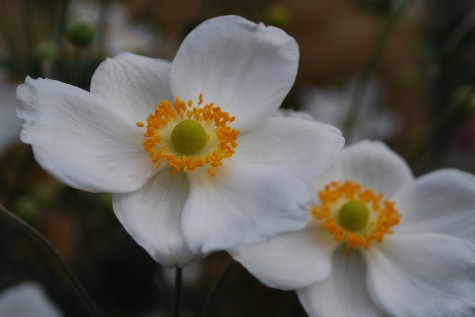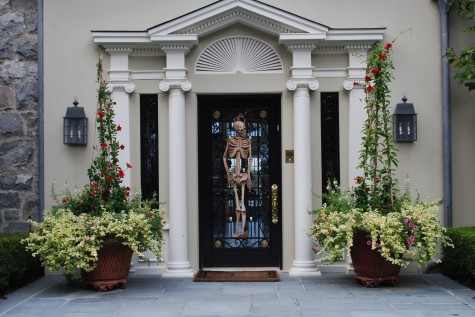 Our weather has taken a turn towards fall; today’s 47 degree temperature is all the more chilly for the 35 mile an hour winds. I was so sure I would have my summer flowers into next week. My clients are much more graceful about moving on to the next season than I am-especially those clients with children. The Halloween holiday-what child isn’t entranced by it? A request for fall pots came from a client with children ready to devote the entire month of October to some ghoulishness.
Our weather has taken a turn towards fall; today’s 47 degree temperature is all the more chilly for the 35 mile an hour winds. I was so sure I would have my summer flowers into next week. My clients are much more graceful about moving on to the next season than I am-especially those clients with children. The Halloween holiday-what child isn’t entranced by it? A request for fall pots came from a client with children ready to devote the entire month of October to some ghoulishness.
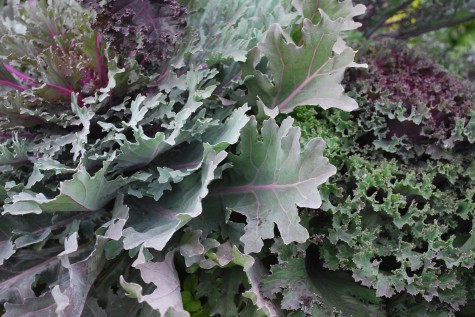 My favorite part of October is that group of leafy plants known as the Brassicas. They come into their own late in the gardening year. Though there is some disagreement about which plants belong to that group, cabbages, kales, cauliflower, and broccoli are prominent members. These cool season annuals are great to eat-but I love how they look. There are many hybrid cabbages and kale that are grown for the beauty of their leaves. As the weather cools, the color intensifies.
My favorite part of October is that group of leafy plants known as the Brassicas. They come into their own late in the gardening year. Though there is some disagreement about which plants belong to that group, cabbages, kales, cauliflower, and broccoli are prominent members. These cool season annuals are great to eat-but I love how they look. There are many hybrid cabbages and kale that are grown for the beauty of their leaves. As the weather cools, the color intensifies.
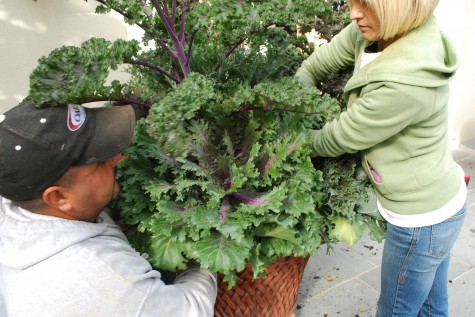 I am indebted to the Brassicas for their scale, mass and texture. Though many plants are tolerant of cold weather – the pansies, certain grasses and so forth-the cabbages and kales can be had of a good size. Our fall season is short, and not so much actual growing goes on. I like planting big right off the bat; some years the fall constitutes but a few weeks. They are not in the least bit fussy about planting depth. If I need to sink them in a pot for a better look, I do so.
I am indebted to the Brassicas for their scale, mass and texture. Though many plants are tolerant of cold weather – the pansies, certain grasses and so forth-the cabbages and kales can be had of a good size. Our fall season is short, and not so much actual growing goes on. I like planting big right off the bat; some years the fall constitutes but a few weeks. They are not in the least bit fussy about planting depth. If I need to sink them in a pot for a better look, I do so.

Some care has to be taken backfilling soil. Those big leaves so beautiful over the edge of a pot make it necessary to get up under there and pack the soil around the rootballs. The same applies to watering. Their massive leaves will shed water from the hose. I water the ground, not the plants. I do like a mix of varieties. The tall spiky redbor kale is a great contrast to the Peacock series cabbage. As these plants are almost full-grown, I will add another element, should I need more height.
 A hazelwood stick covered with grapevine is sunk deep in the soil of the pot. Since wind and rain are more than likely, anchoring any dry materials in a sturdy way is essential. The pod sticks resembling a tritoma have been constructed from overscaled seeds. The entire assemby is glued up on the stick, and sealed. I do make a special effort to find materials like this that can withstand blustery weather.
A hazelwood stick covered with grapevine is sunk deep in the soil of the pot. Since wind and rain are more than likely, anchoring any dry materials in a sturdy way is essential. The pod sticks resembling a tritoma have been constructed from overscaled seeds. The entire assemby is glued up on the stick, and sealed. I do make a special effort to find materials like this that can withstand blustery weather.
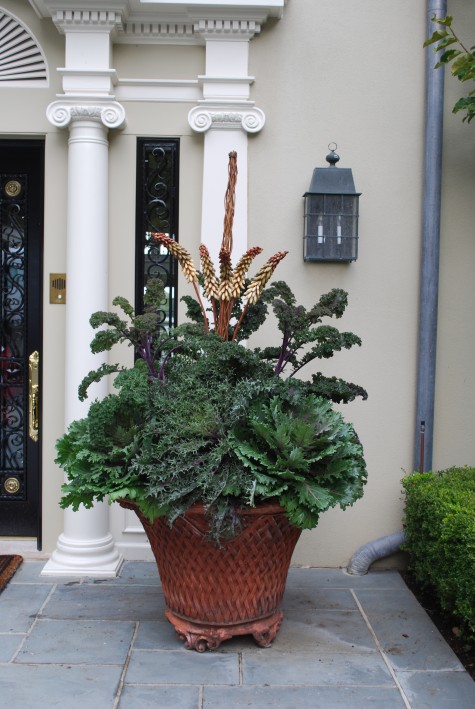 The finished planting is a great scale with a pot this size. The hazelwood stick repeats the basketweave pattern of the pot, and the light colored seed pod stems make reference to the garden gone to seed. The curvy pods echo the curve of the tall kale leaves. I like fall pots with all manner of things in them that refer to the natural world.
The finished planting is a great scale with a pot this size. The hazelwood stick repeats the basketweave pattern of the pot, and the light colored seed pod stems make reference to the garden gone to seed. The curvy pods echo the curve of the tall kale leaves. I like fall pots with all manner of things in them that refer to the natural world.
 The happy accident of this planting-how great those pale pods repeat the color and texture of the skeleton.
The happy accident of this planting-how great those pale pods repeat the color and texture of the skeleton.
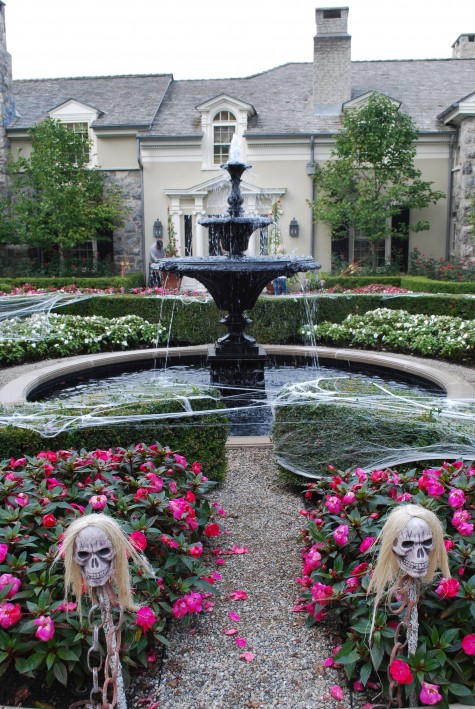
The hair on these skulls-you have to believe that people who dream up Halloween ornaments must have fun. The New Guinea impatiens look like they’ve had a fright, do they not? This landscape is all decked out for a celebration of an October in Michigan.
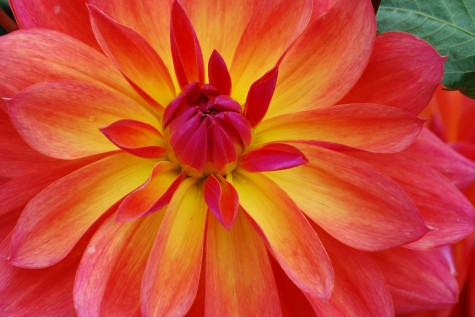 The cultivation of dahlias brings to mind the famed Longfellow little girl verse. “When she was good/She was very very good/But when she was bad she was horrid”. Even if you give them everything you’ve got in the way of rich soil, good sun, staking, fertilization, good air circulation and your utmost devotion, it may not be enough. You still need the blessing of the patron saint of all sulky, troublesome prima donna garden flowers-whomever she may be. Not that one could ask for that blessing; it must be bestowed. I do have one client for whom they perform on demand. He says its the soil-I say what he manages with them is magic.
The cultivation of dahlias brings to mind the famed Longfellow little girl verse. “When she was good/She was very very good/But when she was bad she was horrid”. Even if you give them everything you’ve got in the way of rich soil, good sun, staking, fertilization, good air circulation and your utmost devotion, it may not be enough. You still need the blessing of the patron saint of all sulky, troublesome prima donna garden flowers-whomever she may be. Not that one could ask for that blessing; it must be bestowed. I do have one client for whom they perform on demand. He says its the soil-I say what he manages with them is magic. 
 Some sport blooms so large the word vulgar comes to mind. Some “dinnerplate dahlias” have stems so weak the plant perpetually looks like someone spent the last hour giving them a thorough dressing down. Fungus spreads like crazy from the bottom up; I have grown plenty of dahlia stalks with a few anemic and forlorn flowers on top. When I grow them in pots, I face them down with something that has the decency to grow vigorously, and hide those ungainly dahlia legs.
Some sport blooms so large the word vulgar comes to mind. Some “dinnerplate dahlias” have stems so weak the plant perpetually looks like someone spent the last hour giving them a thorough dressing down. Fungus spreads like crazy from the bottom up; I have grown plenty of dahlia stalks with a few anemic and forlorn flowers on top. When I grow them in pots, I face them down with something that has the decency to grow vigorously, and hide those ungainly dahlia legs.  So why do I grow them? In a good year, they are magnificent. Loaded with flowers, they remind me of the 19th century flower paintings of Rachel Ruysch; they are supremely grand. The range of colors and forms is astonishing. This dahlia is a “formal decorative” type. Park Princess has petals shaped like quills; this form is known as a “cactus dahlia”.
So why do I grow them? In a good year, they are magnificent. Loaded with flowers, they remind me of the 19th century flower paintings of Rachel Ruysch; they are supremely grand. The range of colors and forms is astonishing. This dahlia is a “formal decorative” type. Park Princess has petals shaped like quills; this form is known as a “cactus dahlia”. 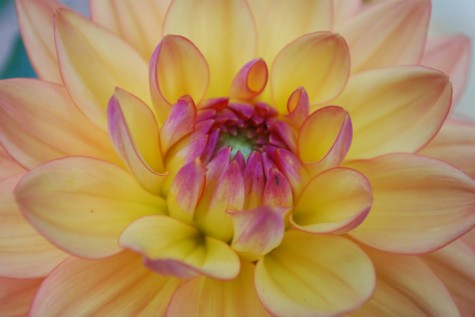
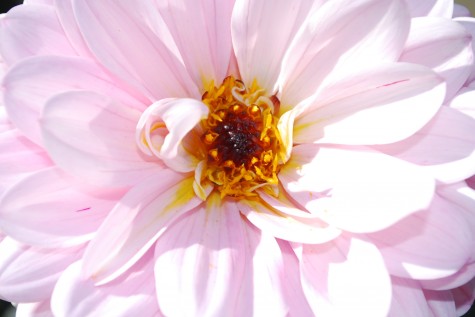 I am looking at these dahlias now as they have been at their peak this first week of October. There is something to recommend about how they last into the fall. They do hate cold weather; the best grown dahlias are those that have spent May and June in a greenhouse. They transition from that museum like setting to the Michigan outdoors poorly. It can take weeks before they loose that insulted look, and take hold.
I am looking at these dahlias now as they have been at their peak this first week of October. There is something to recommend about how they last into the fall. They do hate cold weather; the best grown dahlias are those that have spent May and June in a greenhouse. They transition from that museum like setting to the Michigan outdoors poorly. It can take weeks before they loose that insulted look, and take hold.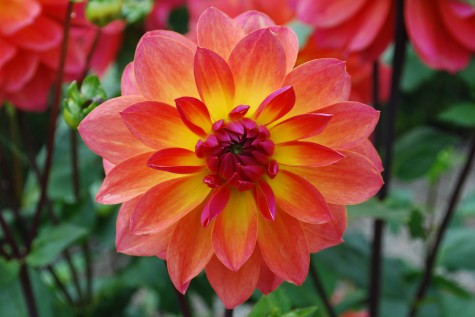 I think a too early planting can set them back such that they never recover. They thrive in that rarefied hothouse atmosphere where wind, bugs, cold soil, and various pathogens are simply not permitted. Dahlias are not great garden plants; they are an event you may wish to attend.
I think a too early planting can set them back such that they never recover. They thrive in that rarefied hothouse atmosphere where wind, bugs, cold soil, and various pathogens are simply not permitted. Dahlias are not great garden plants; they are an event you may wish to attend.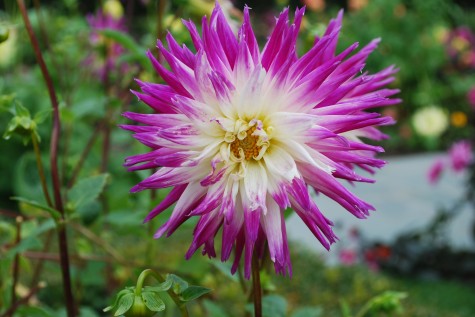 Some of these party girls dress in a way that’s just plain fun to look at. When they are at their overblown best, they make me smile.
Some of these party girls dress in a way that’s just plain fun to look at. When they are at their overblown best, they make me smile.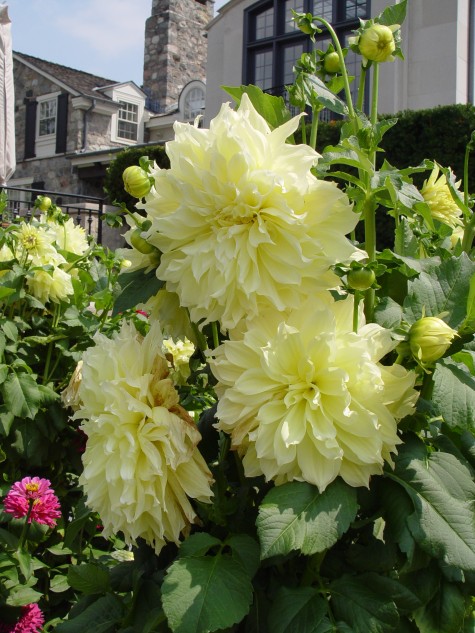
 What could be better than a giant pot stuffed to overflowing with nicotiana? OK, probably plenty of things, but no doubt I am a big fan of the nicotianas. There are a number of ornamental tobaccos suitable for cultivation in our area. The species nicotiana alata pictured above grows strongly to 30″ or better. It has a loose, rangy, and unstructured habit of growth. Sporting clusters of big leaves at the base, the flowers appear all along thin soft stems. They are indeterminate bloomers; a stalk will continue to elongate and produce flowers for months. Once a stalk blooms out, and starts setting seed, I trim it back.
What could be better than a giant pot stuffed to overflowing with nicotiana? OK, probably plenty of things, but no doubt I am a big fan of the nicotianas. There are a number of ornamental tobaccos suitable for cultivation in our area. The species nicotiana alata pictured above grows strongly to 30″ or better. It has a loose, rangy, and unstructured habit of growth. Sporting clusters of big leaves at the base, the flowers appear all along thin soft stems. They are indeterminate bloomers; a stalk will continue to elongate and produce flowers for months. Once a stalk blooms out, and starts setting seed, I trim it back. 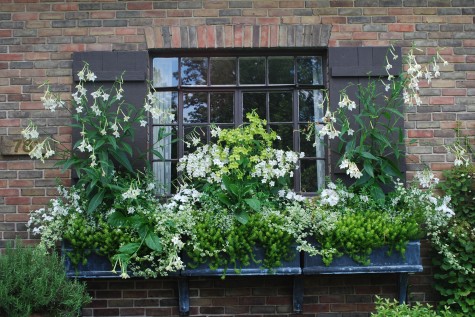

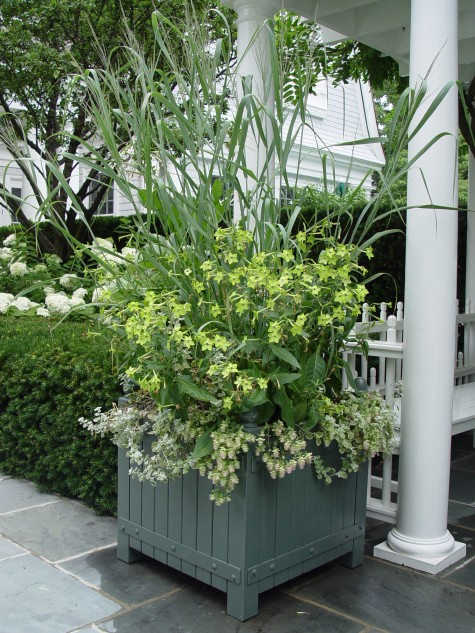 A pairing with Panicum Virgatum Dallas Blues makes that grass all the more icy blue in appearance. Grasses can be difficult to do well in a container, as they are stiff, or awkwardly floppy. Nicotiana makes for a graceful ruff here. They are not without their problems, however. The sticky soft succulent stems are a magnet for aphids. Their giant basil leaves sometimes need pruning back when they threaten to smother something else growing at ground level.
A pairing with Panicum Virgatum Dallas Blues makes that grass all the more icy blue in appearance. Grasses can be difficult to do well in a container, as they are stiff, or awkwardly floppy. Nicotiana makes for a graceful ruff here. They are not without their problems, however. The sticky soft succulent stems are a magnet for aphids. Their giant basil leaves sometimes need pruning back when they threaten to smother something else growing at ground level.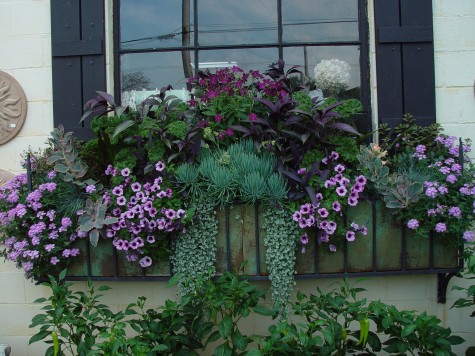
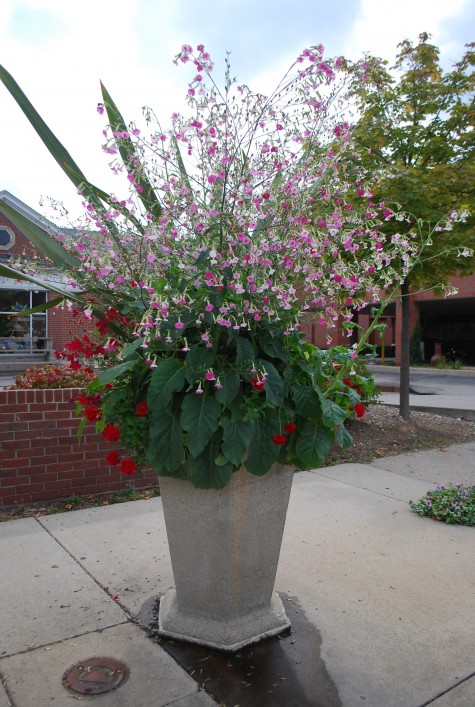 But by far and away my favorite is Nicotiana Mutabilis. It grows tall, and billows out over any edge with a cloud of small flowers that dance in the slightest breeze. Can you tell I like it? The flowers range from white to cream to pale pink to rose pink. This big thing requires secure staking from the beginning. It will pick up speed, and send out new growth from the base of the plant as the night temperatures start to cool.
But by far and away my favorite is Nicotiana Mutabilis. It grows tall, and billows out over any edge with a cloud of small flowers that dance in the slightest breeze. Can you tell I like it? The flowers range from white to cream to pale pink to rose pink. This big thing requires secure staking from the beginning. It will pick up speed, and send out new growth from the base of the plant as the night temperatures start to cool.  They are a nuisance to keep deadheaded-I don’t fuss so much with that. Its hard to spot which stems need headling back, and every part of the plant is sticky. This seems a fairly minor problem to me; a well grow stand of mutabilis is enchanting.
They are a nuisance to keep deadheaded-I don’t fuss so much with that. Its hard to spot which stems need headling back, and every part of the plant is sticky. This seems a fairly minor problem to me; a well grow stand of mutabilis is enchanting.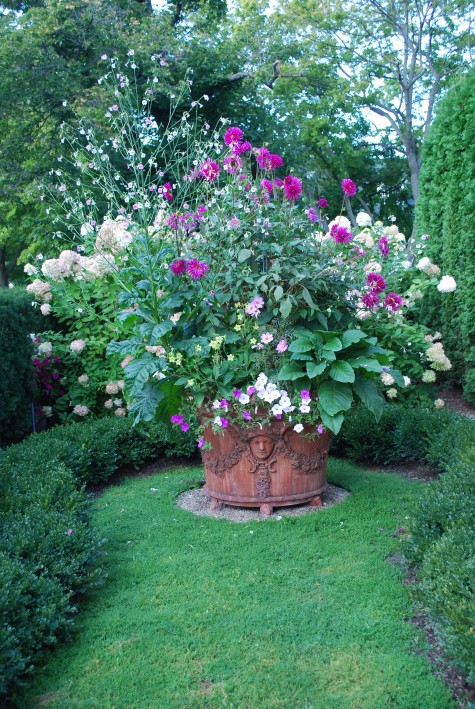 You can see the new growth pushing from the base of this pot on both sides; all of this came on strong in September, and will continue until a hard freeze. They also seem much more aphid-resistant than other nicotianas.
You can see the new growth pushing from the base of this pot on both sides; all of this came on strong in September, and will continue until a hard freeze. They also seem much more aphid-resistant than other nicotianas. The individual flowers are so small and so delicate; the overall picture is delightfully meadow like. All of these nicotianas are a staple of my summer garden.
The individual flowers are so small and so delicate; the overall picture is delightfully meadow like. All of these nicotianas are a staple of my summer garden. There are many species of anemone, but few are quite as lovely as anemone x hybrida “Honorine Jobert. An old garden hybrid discovered in a garden in Verdun France in 1858, it is a star of the fall perennial garden. A good many white flowers are touchy prima donnas that when they are not sulking, perform listlessly. But this anemone shines; it is vigorous, and easy to grow. Though many would say they are best in part shade, I grow mine in full sun on a south wall.
There are many species of anemone, but few are quite as lovely as anemone x hybrida “Honorine Jobert. An old garden hybrid discovered in a garden in Verdun France in 1858, it is a star of the fall perennial garden. A good many white flowers are touchy prima donnas that when they are not sulking, perform listlessly. But this anemone shines; it is vigorous, and easy to grow. Though many would say they are best in part shade, I grow mine in full sun on a south wall. 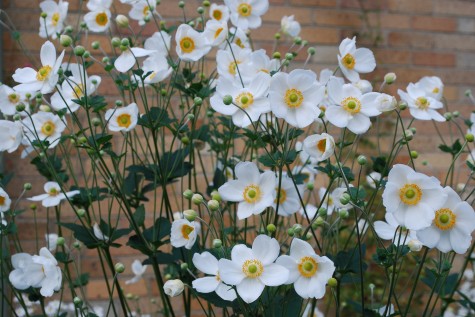
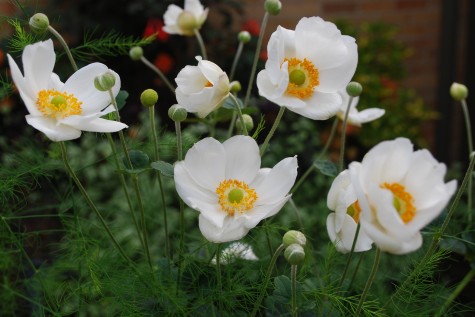 All of the varieties and hybrids of Japanese anemones (which originated in China, by the way) make a great addition to the perennial border. The foliage is dense and low all summer, giving way to impossibly tall flower spikes. The buds dot the stems, and give way to simple 6 to 8 petalled flowers of breathtaking beauty.
All of the varieties and hybrids of Japanese anemones (which originated in China, by the way) make a great addition to the perennial border. The foliage is dense and low all summer, giving way to impossibly tall flower spikes. The buds dot the stems, and give way to simple 6 to 8 petalled flowers of breathtaking beauty. The fringed halo of brilliant yellow stamens encircles the lime green stigma-ooh la la. I have only had trouble growing anemones where the soil drains poorly. As I believe that at least 80 per cent of winter hardiness hinges on good drainage, I plant bog plants in poorly drained areas, and work hard to improve the soil in my perennial gardens. These anemones have been here about nine years. I do have to thin them out in the spring, they are that vigorous.
The fringed halo of brilliant yellow stamens encircles the lime green stigma-ooh la la. I have only had trouble growing anemones where the soil drains poorly. As I believe that at least 80 per cent of winter hardiness hinges on good drainage, I plant bog plants in poorly drained areas, and work hard to improve the soil in my perennial gardens. These anemones have been here about nine years. I do have to thin them out in the spring, they are that vigorous.
